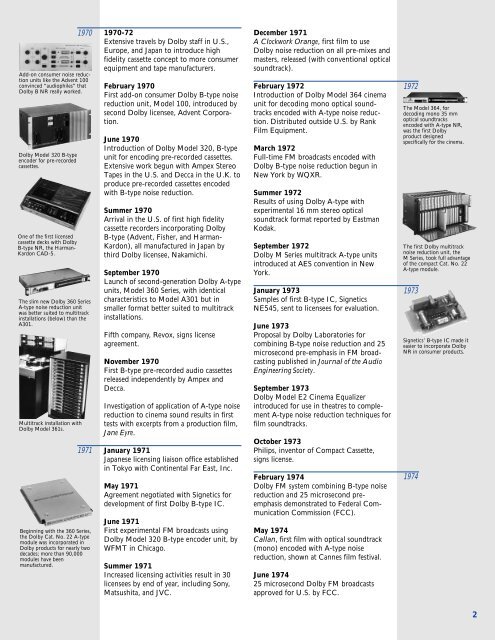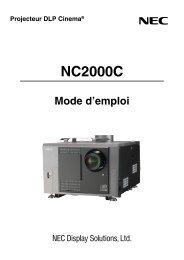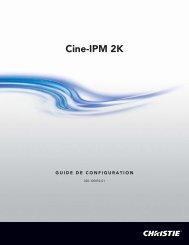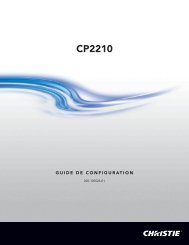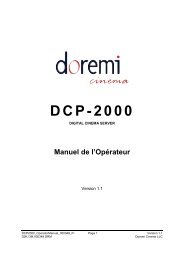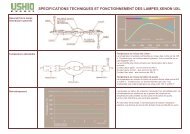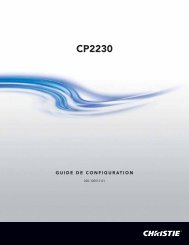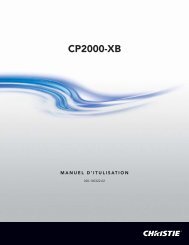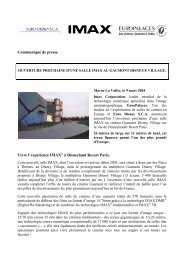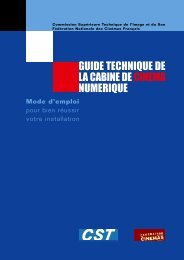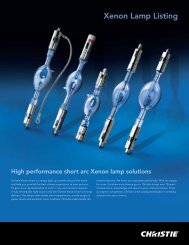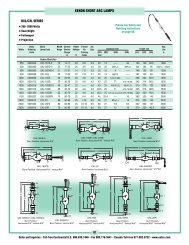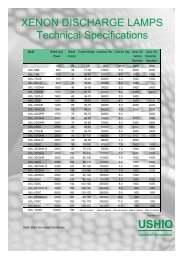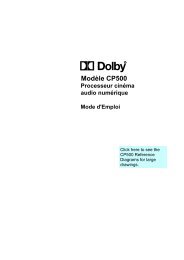A Chronology Of Dolby Laboratories - Projectionniste.net
A Chronology Of Dolby Laboratories - Projectionniste.net
A Chronology Of Dolby Laboratories - Projectionniste.net
You also want an ePaper? Increase the reach of your titles
YUMPU automatically turns print PDFs into web optimized ePapers that Google loves.
1970<br />
Add-on consumer noise reduction<br />
units like the Advent 100<br />
convinced “audiophiles” that<br />
<strong>Dolby</strong> B NR really worked.<br />
<strong>Dolby</strong> Model 320 B-type<br />
encoder for pre-recorded<br />
cassettes.<br />
One of the first licensed<br />
cassette decks with <strong>Dolby</strong><br />
B-type NR, the Harman-<br />
Kardon CAD-5.<br />
The slim new <strong>Dolby</strong> 360 Series<br />
A-type noise reduction unit<br />
was better suited to multitrack<br />
installations (below) than the<br />
A301.<br />
Multitrack installation with<br />
<strong>Dolby</strong> Model 361s.<br />
1971<br />
Beginning with the 360 Series,<br />
the <strong>Dolby</strong> Cat. No. 22 A-type<br />
module was incorporated in<br />
<strong>Dolby</strong> products for nearly two<br />
decades; more than 90,000<br />
modules have been<br />
manufactured.<br />
1970-72<br />
Extensive travels by <strong>Dolby</strong> staff in U.S.,<br />
Europe, and Japan to introduce high<br />
fidelity cassette concept to more consumer<br />
equipment and tape manufacturers.<br />
February 1970<br />
First add-on consumer <strong>Dolby</strong> B-type noise<br />
reduction unit, Model 100, introduced by<br />
second <strong>Dolby</strong> licensee, Advent Corporation.<br />
June 1970<br />
Introduction of <strong>Dolby</strong> Model 320, B-type<br />
unit for encoding pre-recorded cassettes.<br />
Extensive work begun with Ampex Stereo<br />
Tapes in the U.S. and Decca in the U.K. to<br />
produce pre-recorded cassettes encoded<br />
with B-type noise reduction.<br />
Summer 1970<br />
Arrival in the U.S. of first high fidelity<br />
cassette recorders incorporating <strong>Dolby</strong><br />
B-type (Advent, Fisher, and Harman-<br />
Kardon), all manufactured in Japan by<br />
third <strong>Dolby</strong> licensee, Nakamichi.<br />
September 1970<br />
Launch of second-generation <strong>Dolby</strong> A-type<br />
units, Model 360 Series, with identical<br />
characteristics to Model A301 but in<br />
smaller format better suited to multitrack<br />
installations.<br />
Fifth company, Revox, signs license<br />
agreement.<br />
November 1970<br />
First B-type pre-recorded audio cassettes<br />
released independently by Ampex and<br />
Decca.<br />
Investigation of application of A-type noise<br />
reduction to cinema sound results in first<br />
tests with excerpts from a production film,<br />
Jane Eyre.<br />
January 1971<br />
Japanese licensing liaison office established<br />
in Tokyo with Continental Far East, Inc.<br />
May 1971<br />
Agreement negotiated with Sig<strong>net</strong>ics for<br />
development of first <strong>Dolby</strong> B-type IC.<br />
June 1971<br />
First experimental FM broadcasts using<br />
<strong>Dolby</strong> Model 320 B-type encoder unit, by<br />
WFMT in Chicago.<br />
Summer 1971<br />
Increased licensing activities result in 30<br />
licensees by end of year, including Sony,<br />
Matsushita, and JVC.<br />
December 1971<br />
A Clockwork Orange, first film to use<br />
<strong>Dolby</strong> noise reduction on all pre-mixes and<br />
masters, released (with conventional optical<br />
soundtrack).<br />
February 1972<br />
Introduction of <strong>Dolby</strong> Model 364 cinema<br />
unit for decoding mono optical soundtracks<br />
encoded with A-type noise reduction.<br />
Distributed outside U.S. by Rank<br />
Film Equipment.<br />
March 1972<br />
Full-time FM broadcasts encoded with<br />
<strong>Dolby</strong> B-type noise reduction begun in<br />
New York by WQXR.<br />
Summer 1972<br />
Results of using <strong>Dolby</strong> A-type with<br />
experimental 16 mm stereo optical<br />
soundtrack format reported by Eastman<br />
Kodak.<br />
September 1972<br />
<strong>Dolby</strong> M Series multitrack A-type units<br />
introduced at AES convention in New<br />
York.<br />
January 1973<br />
Samples of first B-type IC, Sig<strong>net</strong>ics<br />
NE545, sent to licensees for evaluation.<br />
June 1973<br />
Proposal by <strong>Dolby</strong> <strong>Laboratories</strong> for<br />
combining B-type noise reduction and 25<br />
microsecond pre-emphasis in FM broadcasting<br />
published in Journal of the Audio<br />
Engineering Society.<br />
September 1973<br />
<strong>Dolby</strong> Model E2 Cinema Equalizer<br />
introduced for use in theatres to complement<br />
A-type noise reduction techniques for<br />
film soundtracks.<br />
October 1973<br />
Philips, inventor of Compact Cassette,<br />
signs license.<br />
February 1974<br />
<strong>Dolby</strong> FM system combining B-type noise<br />
reduction and 25 microsecond preemphasis<br />
demonstrated to Federal Communication<br />
Commission (FCC).<br />
May 1974<br />
Callan, first film with optical soundtrack<br />
(mono) encoded with A-type noise<br />
reduction, shown at Cannes film festival.<br />
June 1974<br />
25 microsecond <strong>Dolby</strong> FM broadcasts<br />
approved for U.S. by FCC.<br />
1972<br />
The Model 364, for<br />
decoding mono 35 mm<br />
optical soundtracks<br />
encoded with A-type NR,<br />
was the first <strong>Dolby</strong><br />
product designed<br />
specifically for the cinema.<br />
The first <strong>Dolby</strong> multitrack<br />
noise reduction unit, the<br />
M Series, took full advantage<br />
of the compact Cat. No. 22<br />
A-type module.<br />
1973<br />
Sig<strong>net</strong>ics’ B-type IC made it<br />
easier to incorporate <strong>Dolby</strong><br />
NR in consumer products.<br />
1974<br />
2


